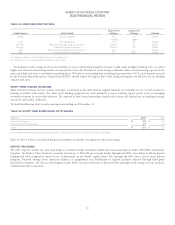American Express 2014 Annual Report Download - page 54
Download and view the complete annual report
Please find page 54 of the 2014 American Express annual report below. You can navigate through the pages in the report by either clicking on the pages listed below, or by using the keyword search tool below to find specific information within the annual report.AMERICAN EXPRESS COMPANY
2014 FINANCIAL REVIEW
We do not engage in derivative financial instruments for trading purposes. Refer to Note 14 to the Consolidated Financial Statements for
further discussion of our derivative financial instruments.
We analyze a variety of scenarios to inform management of potential impacts to earnings and economic value of equity, which may occur
given changes in interest rate curves using a range of severities. As of December 31, 2014, the detrimental effect on our annual net interest
income of a hypothetical 100 basis point increase in interest rates would be approximately $212 million. To calculate this effect, we first
measure the potential change in net interest income over the following 12 months taking into consideration anticipated future business
growth and market-based forward interest rates. We then stress the implied forward interest rate curve with a 100 basis point increase to
measure the impact on the projected net interest income. This effect is primarily driven by the volume of charge card receivables that are
non-interest earning and credit card loans deemed to be fixed-rate, which are funded by variable-rate liabilities. As of December 31, 2014, the
percentage of worldwide charge card accounts receivable and credit card loans that were deemed to be fixed rate was 66.7 percent, or $78
billion, with the remaining 33.3 percent, or $39 billion, deemed to be variable-rate credit card loans.
We are also subject to market risk from changes in the relationship between the benchmark Prime rate that determines the yield on our
variable-rate lending receivables and the benchmark LIBOR rate that determines the effective interest cost on a significant portion of our
outstanding debt. Differences in the rate of change of these two indices, commonly referred to as basis risk, would impact our variable-rate
U.S. lending net interest margins because we borrow at rates based on LIBOR but lend to our customers based on the Prime rate. The
detrimental effect on our net interest income of a hypothetical 10 basis point decrease in the spread between Prime and one-month LIBOR
over the next 12 months is estimated to be $38 million. We currently have approximately $38 billion of Prime-based, variable-rate U.S.
lending receivables and $38 billion of LIBOR-indexed debt, including asset securitizations.
Foreign exchange risk is generated from three principal sources: 1) Card Member cross-currency charges, 2) foreign subsidiary equity and
3) foreign currency earnings in units outside the U.S. Our foreign exchange risk is managed primarily by entering into agreements to buy and
sell currencies on a spot basis or by hedging a significant proportion of our foreign currency earnings. The exposures that are hedged are
based on an economic justification and are executed through various means, including the use of derivative financial instruments such as
foreign exchange forward and cross-currency swap contracts.
As of December 31, 2014 and 2013, foreign currency derivative instruments with total notional amounts of approximately $30 billion and
$27 billion were outstanding, respectively. Derivative hedging activities related to cross-currency charges, balance sheet exposures and
foreign currency earnings generally do not qualify for hedge accounting; however, derivative hedging activities related to translation
exposure of foreign subsidiary equity generally do.
We conduct scenario analysis to inform management of potential impacts to earnings that may occur due to changes in foreign exchange
rates of various severities. With respect to cross-currency charges and balance sheet exposures, including related foreign exchange forward
contracts outstanding, the effect on our earnings of a hypothetical 10 percent change in the value of the U.S. dollar would be immaterial as of
December 31, 2014. With respect to earnings denominated in foreign currencies, the adverse impact on pretax income of a hypothetical 10
percent strengthening of the U.S. dollar related to anticipated overseas operating results for the next 12 months would be approximately $182
million as of December 31, 2014. With respect to translation exposure of foreign subsidiary equity, including related foreign exchange
forward contracts outstanding, a hypothetical 10 percent strengthening in the U.S. dollar would result in an immaterial reduction in equity as
of December 31, 2014.
The actual impact of interest rate and foreign exchange rate changes will depend on, among other factors, the timing of rate changes, the
extent to which different rates do not move in the same direction or in the same direction to the same degree, changes in the cost, volume
and mix of our hedging activities and changes in the volume and mix of our businesses.
FUNDING & LIQUIDITY RISK MANAGEMENT PROCESS
Liquidity risk is defined as our inability to meet our ongoing financial and business obligations as they become due at a reasonable cost.
General principles and our overall framework for managing liquidity risk are defined in the Liquidity Risk Policy approved by the Risk
Committee of the Board of Directors and the ALCO. Liquidity risk limits are approved by the Risk Committee of the Board of Directors and
the ERMC. Liquidity risk is centrally managed by the Funding and Liquidity Committee, which reports into the ALCO. In addition, the
Market Risk Oversight Officer provides independent oversight of liquidity risk. We manage liquidity risk by maintaining access to a diverse
set of cash, readily-marketable securities and contingent sources of liquidity, such that we can continuously meet our business requirements
and expected future financing obligations for at least a 12-month period, even in the event we are unable to raise new funds under our
regular funding programs during a substantial weakening in economic conditions. We balance the trade-offs between maintaining too much
liquidity, which can be costly and limit financial flexibility, and having inadequate liquidity, which may result in financial distress during a
liquidity event.
54
























